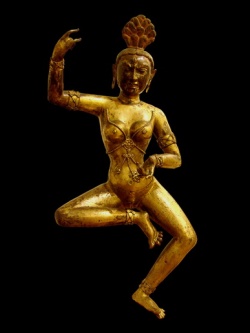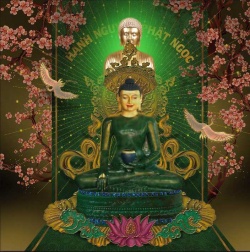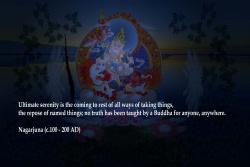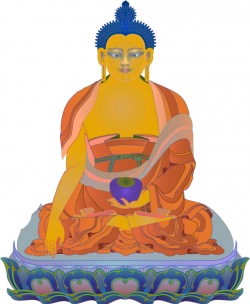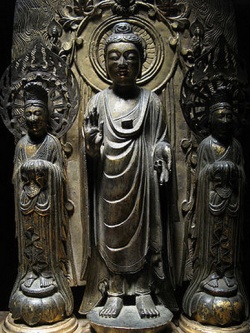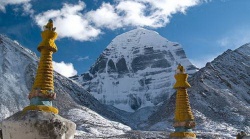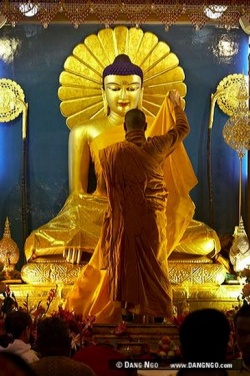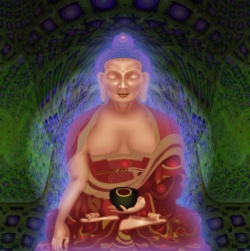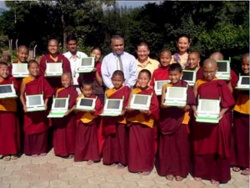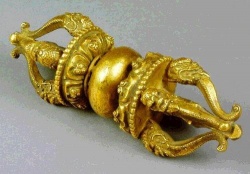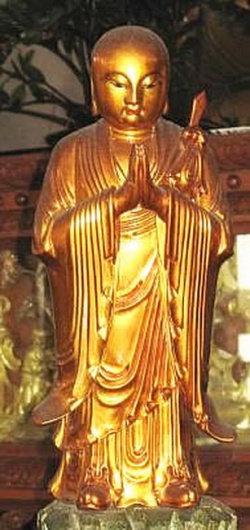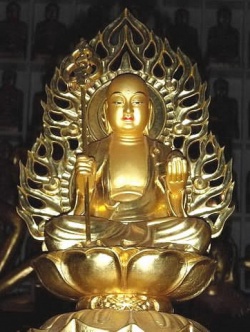Completion stage
The completion stage (Tibetan:dzog rim, (Wyl., rdzogs rim); Sanskrit:saṃpanna-krama) is one of the two stages of Anuttarayoga Tantra and Anuyoga.
Completion stage may also be translated as perfection stage or fulfillment mode.
The generation stage (Tibetan:kye rim; Sanskrit:utpatti-krama) generally precedes the completion stage.
Completion stage practices are associated with working with lung and the body.
Definition
The Dharma Dictionary defines the 'Completion Stage' as follows:
- One of the two aspects of Vajrayana Practice.
The meaning and depth of this principle changes while ascending through the three outer sections of Tantra and the three inner sections of Tantra)].
For instance, the completion stage defined as the dissolving of the visualization of a deity corresponds to Mahayoga;
the "Completion stage with marks" based on yogic practices such as tummo corresponds to Anu Yoga: and the
"Completion stage without marks" is the practice of Ati Yoga.
The completion stage engages creative imagination or visualization and emphasizes the voidness aspect of reality as a skillful means of personal transformation.
The completion stage employs the "mystic vortices" of the body, the cakra, the subtle energy of the subtle body, the five pranas or vāyu,
together with the channels, the nadi through which the energy flows in order to generate the 'great bliss' (Tibetan:
Dem Chog or bde-mchog; Sanskrit: Maha-sukha) associated with bodhi or enlightenment.
Keith Dowman, in elucidating the spiritual disciplines of the Mahasiddhas, links the completion stage with the Two Truths, voidness, along with a suite of advanced Mahamudra sadhana and other practices that are related to the Six Yogas of Naropa such as tummo:
- Fulfillment meditation includes "highe techniques of meditation, which result in understanding of ultimate truth.
But since relative and ultimate truth are two sides of the same coin, creative and fulfillment stages both lead to the same goal.
Fundamentally, fulfillment meditation techniques entail the perception of emptiness in form, or the dissolution of form into emptiness: the dissolution of the creative stage vision into emptiness is technically a fulfillment stage practice.
Examples of fulfillment mode yogas are:
dream yoga, the
yoga of the mystic heat,
Mahamudra meditation, the
yoga of the apparitional body, the
yoga of resurrection,
clear light meditation, and the
yoga of uniting skillful means (upaya) and
perfect insight (prajna) to create the seed-essence of pure pleasure.
"Seed-essence" is a rendering of tigle and changchubsem = 'seed-essence' = yang life-force = white bodhicitta.
Seed-essence (Sanskrit: bija-tattva) is cognate with bindu (Sanskrit) and gankyil (Tibetan).
Dowman further maps the instrumentation of "fulfillment meditation" in relation to the Mahamudra kundalini raising of the 'phowa of Great Transference' ("ultimate liberation") through the cranial fontanelle at the 'Bardo of Death' and a subsidiary preparatory sexual yoga:
- The system of visualization vital in fulfillment meditation is that of the subtle body.
This imaginary subtle body consists of:
psychic nerves - nadi, their focal points or energy centers -
cakras; the nerves -
prana; and the
essence of prana, known as "seed-essence" or bindu.
A central channel, or nerve, runs from the sexual center to the fontanelle, and the left, rasana, and right, lalana, channels run parallel joining the central channel, the avadhuti, at the gut center.
Converging from all parts of the body like physical veins, subsidiary nerves enter the central channel at the five focal points of psychic energy: - the
sexual,
gut,
heart,
throat and
head centers.
Visualization of this system allows the yogin to manipulate the energies relating to the various centers for different mundane purposes, but the highest aim is to inject all energy into the central channel and up to the head center where ultimate liberation is achieved.
The key to this system relates right and left channels to skillful means (male) and perfect insight (female) respectively, and the central channel to their union - Mahamudra.
In an important sexual yoga, with or without a sexual partner, red and white seed-essence, bodhicittas, are mixed in the sexual center to rise up the central channel as kundalini.
This is the yoga of uniting pure pleasure and emptiness.
Jake Dalton states that:
- The perfection stage practices are often divided into those:
without signs (mtshan med) and those
with signs (mtshan bcas).
The former refer to practices in which the enlightened view is accomplished instantaneously, without any effort, “like a fish leaping out of the water.”
The latter – the practices with signs – are generally the perfection stage practices known collectively as “channels and winds” (rtsa lung).
Here, the practitioner works with a system of channels within one’s body, through which are moving the “winds” – subtle energies closely related to one’s mind.
Berzin frames the energetic process of the completion stage and in so doing, mentions the Clear Light, the Illusory Body, and the Rupakaya:
- On the complete stage, we cause the energy-winds (rlung, Skt. prana) to enter, abide, and dissolve in the central channel.
This enables us to access the subtlest level of mental activity (clear light, ‘ od-gsal) and use it for the nonconceptual cognition of voidness – the immediate cause for the omniscient mind of a Buddha.
We use the subtlest level of energy-wind, which supports clear light mental activity, to arise in the form of an illusory body (sgyu-lus) as the immediate cause for the network of form bodies (Skt. rupakaya) of a Buddha.
There are different kinds of activities that can be done on the basis of the deity yoga practiced I the generation stage.
Consistently engaging in such forms of practice, the meditator will reach a point where he or she will begin to feel the physical effect of these practices.
Experiencing this special physical effect within your body marks the attainment of the first level of completion stage.
There are many different types of completion stage practice, such as the
yoga of inner heat,
wind yoga – that is yoga that makes use of the currents of energy – and the
yoga of the four joys and so forth.
Wind yoga includes such techniques as holding the vase breath or what is technically referred to as vajra repetition.
At that point a lay practitioner can seek the assistance of a consort.
But if the practitioner is an ordained person holding monastic vows, the point has not yet been reached.
In order to engage in such profound practices of the completion stage, the practitioner should first be aware of the structure of his or her own body.
This means understanding the stationary channels, the flowing energies and the drops that reside in certain parts of the body.
When we speak of channels, we generally refer to three main ones – the central channel, right channel's and left channels – and also the five channel wheels or energy centres.
These three main channels branch and re-branch so that there are, according to tantric texts, 72,000 channels in the body. Some sutras also mention 80,000 channels within the body.
Then, there are the flowing energies. These are of ten types, five major energies and the five minor ones.
The drops refer to the:
white element and
the red element.
The Kalachakra tantra refers to four types of drops:
the drop between the brows, which becomes manifest during the waking period; the drop at the throat, which becomes manifest during the dream state; the drop at the heart, which becomes manifest at the time of deep sleep; and the drop at the navel, which becomes manifest at the fourth stage (death).
In the Kalachakra we find very detailed explanations of these things.
The entire structure of the practitioner’s body with its channels, energies and the drops is called the internal Kalachakra, which is the basis of purification.
The Kalachakra Tantra speaks of three types of Kalachakra or wheel of time, the:
outer,
inner and the
alternative Kalachakras.
Based on the proper knowledge of the physical structure of his or her body, when the meditator focuses on certain vital points and penetrates them, he or she is able to withdraw and dissolve the flow of the gross level of wind and mind.
Eventually, the practitioner will be able to generate the subtlest level of clear light, the clear light of death, into an entity of the path which is the wisdom realizing emptiness.
Gaining such a realization is like having found the key which provides access to many treasures.
Once you achieve that stage and you have the key, you can attain the complete enlightenment of Buddhahood through the path of Guhyasamaja, that is by actualizaing the illusory body as explained in the Guhyasamaja,
or through the path of Kalachakra which speaks of the achievement of empty form, or through the rainbow body as explained in the Mayajala Tantra, which is also explained in the Great Perfection practices.
When a meditator has gained a certain control over his mind during the waking state, he or she begins to utilize even the dream state in the practice of the path and certain techniques are described for doing this.
These kinds of meditations are called ‘mixings’, mixing during the waking state, during the dream state and during death.
Highest Yoga Tantra explains that the best practitioner is someone who is able to attain complete enlightenment within his or her lifetime.
Those with middling faculties are able to attain complete enlightenment during the intermediate state and those of inferior ability will be able to attain it during their future lives.
For those practitioners who will become enlightened during the intermediate state or during their future lives, practices such as the transference of consciousness are explained.
There is also another practice quite similar to the transference of consciousness, but with the difference that the consciousness is transferred into another being’s boy or corpse.
These techniques belong to what are called the Six Yogas of Naropa, which are techniques Naropa extracted from many different tantras.
These are among the basic practices of the Kagyu tradition.
There is also a Gelug practice of the Six Yogas of Naropa derived from Marpa’s tradition. These meditations can also be found in the Sakya practices of Path and Fruit and in the Nyingma practice of the Heart’s Drop.
We have been discussing the Highest Yoga Tantra procedures according to the new tradition.
But the old tradition or old transmission school, the Nyingma, refers to the Great Perfection Vechile, whose practices consist of the Mind Collection, the Centredness Collection and the Collection of Quintessential Instructions.
Although there are many works on these topics, it is very difficult to perceive the subtleties of these different practices. Among these three collections, the Collection of Quintessential Instruction sis said to be the most profound.
We can say that the practices of the first two Collections lay the foundations for the practice of ‘break-through’.
The view of emptiness explained in the Mind and Centredness Collections must have some features that distinguish it from the view of emptiness expounded in the low vehicle, but it is difficult to explain this clearly in words.
The practices of the Collection of Quintessential Instructions have two aims:
actualization of the Truth Body and
actualization of the Enjoyment Body.
The paths by which you actualize these two bodies of the Buddha are the practice of ‘breakthrough’ and ‘leap-over’.
Through understanding these elements of the Great Perfection School, you can understand what is meant by the Great Perfection of the base, the Great Perfection of the path and the Great Perfection of the resultant state.
As I have remarked before, these are factors that can be understood only through experience and cannot be explained merely through words.
However, you can appreciate the extent of their profundity and difficulty by reading Long-chen-pa’s text on the Great Perfection practices called Treasury of the Supreme Vechile,
although the fundamental text as well as the commentary to it is very large and difficult to understand.
He has also composed a text called the Treasury of Reality, which also outlines the practices of the Great Perfection.
You can only hope to gain a good understanding of the Great Perfection if you are able to explain the practices of the Great perfection according to these two texts of Long-chen-pa.
It is also important to study Kunkhyen Jigme Linpa’s text on the Great Perfection called the Treasury of Virtue, in the second volume of which you will find explanations of Great Perfection practices.
There are also very short and succinct texts composed by masters who have themselves had experience of the Great Perfection.
I myself believe that these texts were composed by highly realized masters who have been able to extract the essence of all the elements of the Great Perfection and its practices and as a result have been able to recount their experiences in a very few words.
However, I think it would be very difficult to try to understand the practice of the Great Perfection on the basis of these short texts.
For example, when Lord Buddha taught the Perfection of Wisdom sutras, the shortest one consisted of the single syllable ‘Ah’.
This sutra is said to encompass the entire meaning of the Perfection of Wisdom sutras, but it would be either too simple or too difficult if we were to try to study the Perfection of Wisdom on the basis of that sutra.
To say ‘Ah’ is very simple, but it doesn’t mean we have understood the meaning of the sutra.
When we study the Middle Way philosophy in all its complexity, studying the different reasons through which we can arrive at the conclusion that all phenomena lack inherent existence,
if we are to understand all the subtleties and implications of such a philosophical view, it is also necessary to understand the viewpoint of the lower schools of thought.
The conclusion you then arrive at is very simple.
Because things are interdependent, and rely on other causal factors, they lack an independent nature or inherent existence.
But if you were to approach the Middle Way Consequentialist view of emptiness right from the beginning with that simple statement, ‘Because things are interdependent or dependently arising, they are empty of inherent existence’, you would not fully understand what it meant or implied.
If, in a similar way, you were to read a short text composed by an inexperienced lama on the Great Perfection and were to conclude that the view of the Great Perfection was very simple, that would be a sign that you had not understood it properly.
It would also be very ironic if the highest of the nine vehicles could also be said to be the simplest.
And with this I come to an end of my survey of all the Buddhist practices including the systems of both sutra and tantra undertaken in the Tibetan tradition.
